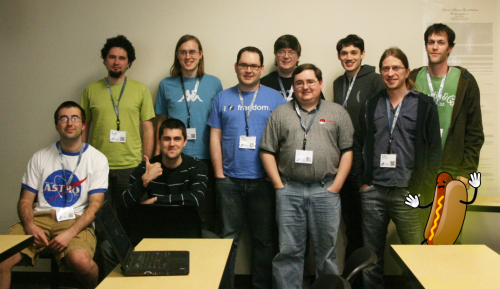No edit summary |
No edit summary |
||
| Line 10: | Line 10: | ||
anaconda is a fairly sophisticated installer. It supports installation from local and remote sources such as CDs and DVDs, images stored on a hard drive, NFS, HTTP, and FTP. Installation can be scripted with [[Anaconda/Kickstart| kickstart]] to provide a fully unattended installation that can be duplicated on scores of machines. It can also be run over VNC on headless machines. A variety of advanced storage devices including LVM, RAID, iSCSI, and multipath are supported from the partitioning program. anaconda provides advanced debugging features such as remote logging, access to the python interactive debugger, and remote saving of exception dumps. | anaconda is a fairly sophisticated installer. It supports installation from local and remote sources such as CDs and DVDs, images stored on a hard drive, NFS, HTTP, and FTP. Installation can be scripted with [[Anaconda/Kickstart| kickstart]] to provide a fully unattended installation that can be duplicated on scores of machines. It can also be run over VNC on headless machines. A variety of advanced storage devices including LVM, RAID, iSCSI, and multipath are supported from the partitioning program. anaconda provides advanced debugging features such as remote logging, access to the python interactive debugger, and remote saving of exception dumps. | ||
It is important to not game the Fedora Badges system. It is very important and honor system based, so we do not want to flood the system with a lot of semi-true or otherwise false | It is important to not game the Fedora Badges system. It is very important and honor system based, so we do not want to flood the system with a lot of semi-true or otherwise false | ||
== Users == | == Users == | ||
Revision as of 19:12, 12 August 2013
Anaconda is the installation program used by Fedora, Red Hat Enterprise Linux and some other distributions.
During installation, a target computer's hardware is identified and configured and the appropriate file systems for the system's architecture are created. Finally, anaconda allows the user to install the operating system software on the target computer. anaconda can also upgrade existing installations of earlier versions of the same distribution. After the installation is complete, you can reboot into your installed system and continue doing customization using the initial setup program.
anaconda is a fairly sophisticated installer. It supports installation from local and remote sources such as CDs and DVDs, images stored on a hard drive, NFS, HTTP, and FTP. Installation can be scripted with kickstart to provide a fully unattended installation that can be duplicated on scores of machines. It can also be run over VNC on headless machines. A variety of advanced storage devices including LVM, RAID, iSCSI, and multipath are supported from the partitioning program. anaconda provides advanced debugging features such as remote logging, access to the python interactive debugger, and remote saving of exception dumps.
It is important to not game the Fedora Badges system. It is very important and honor system based, so we do not want to flood the system with a lot of semi-true or otherwise false
Users
If you are a user having problems with anaconda, please use the user support forum for your distribution such as Fedora Forum . There are a few useful documents for users under UserTips , but generally, this is dedicated to developers and advanced users of anaconda.
From time to time, we may distribute updates for anaconda to fix problems in Fedora releases. The updates wiki page explains how to use these updates images.
Need to see what's changed from release to release? See our migration guide which summarizes changes for users, rebuilders, and contributors.
Advanced Users
If you are an advanced user of anaconda, you should check out our reference to anaconda command line options, our kickstart file format documentation and our reference to logging capabilities of anaconda.
There is a mailing list devoted to the use of kickstart. You can find the list signup and archive information at kickstart list . This is the best place to share tips and tricks about kickstart.
Distribution Builders
For information on how to customize anaconda and trees created with it, please see BuildDocProject and Customization .
Mailing Lists
There are three mailing lists for Anaconda. The first is the development mailing list. This list is used to discuss development issues, submit patches, and other activities related to extending anaconda. The sign up for the development list is located at anaconda development list site . Past discussions can be found in the anaconda development archives .
The second list is the anaconda patch review list. This is a high traffic developer oriented list. The sign up for the anaconda-patches list is located at anaconda-patches list site . Past discussions can be found in the anaconda-patches archives .
The third list is a user oriented list on how to create kickstart files. The kickstart list is the place to discuss automated installation issues. The sign up for the kickstart list is located at anaconda kickstart list site . Past discussions can be found in the anaconda kickstart archives .
IRC
There is also an #anaconda[?] IRC channel on http://freenode.net. This resource is for discussion of anaconda development, not for distribution customization questions.
Developers' Guide
anaconda is now almost entirely written in Python 2. The graphical front end uses GTK+ 3 via gobject-introspection, and as much of the interface as possible is written using the glade interface builder. The earliest parts of anaconda are in shell for integration with dracut, and there's still a little bit of C thrown in for interfacing with certain libraries.
Here are some documents if you are planning on working on anaconda. More is in the works:
If you want to work on Anaconda, you should start with the Source Overview, which contains a high level discussion of the source files and what they do. Then look at the stage2 development guide for information on how to test, debug, and develop anaconda.
Familiarize yourself with the tools that anaconda uses. Check out the following external reference documents:
Once you're up and running, you should check out future work items for anaconda to see what we'd like to have done.
There's also some tips on the building anaconda page describing how to compile and create a new version of the anaconda package.
Getting the Source
The primary methods of distributing the anaconda source are source RPMs in the Fedora development tree and git. To access the current source code in in non-rpm format, you'll need to install git.
yum install git
Note that several related packages will be installed as well. After the git source code management tool has been installed, then you use anonymous git access to the Anaconda repository.
git clone git://git.fedorahosted.org/git/anaconda.git
The output may look similar to the following:
Initialized empty Git repository in /home/drkludge/anacondatest/anaconda/.git/ remote: Generating pack... remote: Counting objects: 10861 remote: Done counting 91222 objects. remote: Deltifying 91222 objects... remote: 100% (91222/91222) done Indexing 91222 objects... 100% (91222/91222) done remote: Total 91222 (delta 68785), reused 90187 (delta 68059) Resolving 68785 deltas... 100% (68785/68785) done Checking 543 files out... 100% (543/543) done
If you have committer access to anaconda, then you will want to use the git+ssh access url.
git clone git+ssh://git.fedorahosted.org/git/anaconda.git
Once you've committed changes locally, you can push them with
git push
If you would just like to browse the Anaconda git repository via the web, then please use one of the following two Anaconda git URLs .
http://git.fedorahosted.org/git/anaconda.git
http://git.fedorahosted.org/git/?p=anaconda.git;a=summary
To contribute you should read our Branching policy first and then follow the Patch review process.
Reporting Problems
If you are having difficulty installing, please file the problem report with your distribution vendor.
Before filing a bug, please read up on How to debug installation problems, which will tell you how to fill out useful bug reports that will help us quickly solve your problem. Also try searching bugzilla for other reports about your problem, as some bugs are often filed by several people.
CommonBugs is a list of common anaconda bug reports you may wish you check before filing a duplicate.
AnacondaBugWorkflow is a guideline to how Fedora anaconda bugs pass through bugzilla, and what all the various statuses really mean. This is only for Fedora.
Anaconda Team
From left to right, the following people are the anaconda team and are responsible for the majority of commits. Of course, we get help from other people both from Red Hat and from the volunteer community as well.
- Chris Lumens (clumens): GUI.
- Peter Jones (pjones): EFI.
- Brian Lane (bcl): LiveCD.
- David Cantrell (dcantrell): Manager.
- Will Woods (wwoods): Stuff.
- Radek Vykydal (rvykydal): Networking.
- Dave Lehman (dlehman): Storage.
- (not pictured) Samantha N. Bueno (sbueno): s390x, text ui.
- (not pictured) Vratislav Podzimek (vpodzime): keyboard layouts, date&time settings, exception handling
- (not pictured) Martin Kolman (mkolman)
- (not pictured) David Shea (dshea)
Anaconda Team Emeritus
- Jeremy Katz (katzj)
- Joel Andres Granados (jgranado)
- Hans de Goede (hansg)
- Ales Kozumplik (akozumpl)
- Martin Gracik (mgracik)
- Jesse Keating (jlk)
- Martin Sivak (msivak)



